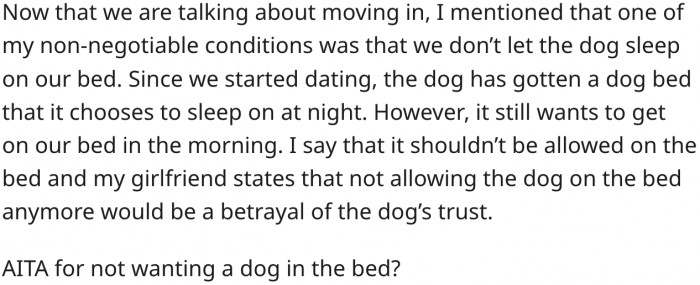Boyfriend Doesn't Like Sharing His Bed With Girlfriend's Dog But She Disagrees
Zanman1010 on Reddit took to the AITA subreddit to share an issue he's having with his girlfriend over her English bulldog. Zanman1010 and his girlfriend have been dating for two and a half years and are considering moving in together next summer once Zanman1010's lease ends.
Zanman1010's girlfriend owns a 9-year-old English bulldog that has been a significant part of her life. Zanman1010 loves the dog and enjoys spending time with it when he is at his girlfriend's house.
However, the dog has always slept on the bed with them when Zanman1010 stays over. Zanman1010 has never been a fan of dogs sleeping on the bed but decided not to bring it up at the beginning of their relationship.
Now that they are discussing moving in together, Zanman1010 mentioned that one of his non-negotiable conditions is that the dog will not be allowed to sleep on their bed. The dog has a dog bed that it chooses to sleep on at night but still wants to get on the bed in the morning.
Zanman1010 believes that the dog should not be allowed on the bed, but his girlfriend thinks that not allowing the dog on the bed would be a betrayal of the dog's trust. Zanman1010 shared this situation on Reddit and asked if he is the a-hole for not wanting the dog in the bed.
Here's how it began.

She disagrees, but here's what Reddit thinks

1. He can't win this particular disagreement.

The Dynamics of Shared Spaces
Sharing personal spaces, like a bed, with pets can evoke a range of emotional responses and conflicts in relationships. According to Dr. John Archer, a psychologist specializing in human-animal relationships, many people view their pets as family members, which can lead to tension when boundaries are crossed. This dynamic often intersects with attachment theory, where individuals may experience anxiety when their pet's needs appear to conflict with their own.
Moreover, the attachment styles of both partners in the relationship can influence how they perceive pet behaviors. Research indicates that individuals with secure attachment styles are more likely to accommodate their partner's preferences regarding pet interactions, while those with insecure styles may feel threatened or defensive.
Negotiating Spaces in Relationships
The conflict over sharing a bed with a pet highlights important dynamics in relationships regarding space and boundaries.
Research by Dr. John Gottman emphasizes that understanding and respecting each partner's needs is crucial for maintaining harmony in relationships.
When one partner feels uncomfortable with the presence of a pet, it can create tension that needs to be addressed through open dialogue.
2. He should not make his girlfriend choose between him and her dog.

3. He made a mistake by not telling the truth sooner.

4. It's too late to change the dog's sleeping habits.

From a behavioral perspective, the reluctance to share space with a pet can indicate underlying discomfort with boundaries and personal space. A study by Dr. Patricia McConnell highlights how misunderstandings about animal behavior can lead to conflict in shared living situations. This conflict can create stress and resentment, particularly if one partner feels their needs are consistently overlooked.
Studies indicate that couples who engage in effective communication about their preferences are more likely to experience relationship satisfaction.
Dr. Susan Johnson's work on attachment theory emphasizes that partners must feel secure and understood to foster healthy emotional connections.
This suggests that discussing boundaries around shared spaces can enhance both emotional intimacy and relationship dynamics.
5. He should find ways to cope with the dog.

6. His dishonesty from the beginning of the relationship is a red flag.

7. Moving in together might not be a good idea at this time.

Addressing Relationship Conflicts
To navigate the complexities of pet ownership within relationships, open communication is essential. Couples are encouraged to discuss their feelings and concerns openly, setting boundaries that respect both partners' needs. Engaging in active listening can promote understanding and help couples find compromise solutions that honor both the pet and the relationship.
Additionally, establishing designated pet-free zones can help alleviate tension. Creating spaces where both partners feel comfortable can enhance the overall harmony within the relationship while accommodating the needs of the pet.
Balancing Compromise and Personal Comfort
Finding a balance between personal comfort and compromise is essential in navigating relationship challenges.
According to Dr. Brené Brown, embracing vulnerability can lead to deeper connections and understanding between partners.
Being open about feelings regarding pet sharing can lead to more empathetic discussions and solutions.
8. The dog won't be around forever.

9. He should get ready to sleep alone.

10. His girlfriend might have ended their relationship if he had brought it up earlier.

Furthermore, couples may benefit from involving a pet behaviorist to mediate discussions about pet interactions. These professionals can provide insights into canine behavior, helping partners understand their pet's needs while promoting a cooperative approach to shared spaces. This collaboration can lead to healthier dynamics and more satisfying relationships.
To facilitate compromise, couples may consider engaging in structured conversations about their comfort levels with pets in shared spaces.
Utilizing 'I' statements to express feelings, such as 'I feel uncomfortable sharing the bed with the dog,' can promote understanding and empathy.
This approach encourages collaboration in finding solutions that honor both partners' needs.
11. He shouldn't have pretended to be okay with it for years.

12. He should decide whether his girlfriend is worth sacrificing for or not.

13. They should wait a while before moving in together.

The Role of Attachment in Relationships
The attachment styles of both partners can significantly influence their comfort levels regarding shared spaces.
Research indicates that individuals with secure attachment styles are generally more open to compromise and adaptability in relationships.
Conversely, those with anxious or avoidant attachment styles may struggle with boundaries and personal comfort, leading to conflict.
14. The conditions should have been disclosed earlier in the relationship.

15. When you love someone, you have to love their dog too.

16. The routine predates him.

Understanding each partner's attachment style can provide valuable insights into their preferences and responses to shared spaces.
Engaging in discussions about these styles can foster compassion and empathy, allowing couples to navigate conflicts more effectively.
Creating a safe space for sharing feelings can enhance emotional intimacy and relationship satisfaction.
17. Things would have been different if they had had the conversation at the start of their relationship.

18. He hid the information from his girlfriend because he knew she would end the relationship.

19. The dog is nearing the end of its lifespan.

Creating Shared Comfort Zones
Developing a shared comfort zone is essential for maintaining relationship harmony, especially when pets are involved.
According to Dr. Harville Hendrix, creating a nurturing environment that respects both partners' needs can enhance relationship satisfaction.
By collaboratively establishing boundaries around pet interactions, couples can strengthen their bond.
20. They should consider a compromise that works for both of them.

What Do You Think?
Communication is a crucial aspect of any relationship, as it allows individuals to express their needs and concerns, understand each other's perspectives, and work together to find solutions to conflicts and challenges.
Without open and honest communication, misunderstandings and resentment can build up, leading to a breakdown of trust and connection.
Therefore, it is essential to prioritize communication in any relationship in order to foster a healthy and strong bond. What do you think about OP's situation?
To create shared comfort zones, couples can designate specific areas in the home for pets and for personal space, allowing for flexibility and comfort.
This approach not only respects individual preferences but also fosters a sense of partnership in navigating shared living spaces.
Ultimately, prioritizing mutual satisfaction can lead to a more harmonious and fulfilling relationship.
Psychological Analysis
This scenario highlights the complexities of balancing personal comfort and shared responsibilities in relationships. The presence of a pet can evoke strong feelings about boundaries and space, necessitating open communication. Addressing these issues collaboratively can enhance emotional intimacy and satisfaction for both partners.
Analysis generated by AI
Analysis & Alternative Approaches
In conclusion, navigating shared spaces in relationships requires a balance of understanding, compromise, and respect for personal boundaries.
By prioritizing open communication about comfort levels and preferences, couples can foster stronger emotional connections and relationship satisfaction.
Ultimately, creating shared comfort zones can enrich the partnership and enhance overall well-being.
Analysis & Alternative Approaches
In conclusion, navigating the complexities of pet ownership within relationships requires clear communication and mutual understanding. By recognizing the emotional dynamics at play and establishing healthy boundaries, couples can foster a more harmonious living environment. Promoting respect for both partners' needs can enhance the bond between them while ensuring the well-being of their pet.



